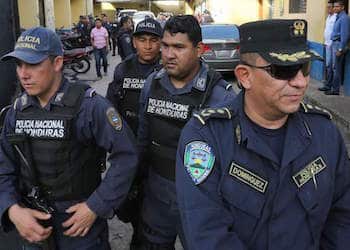A new report mapping violence in Honduras’ capital suggests that the country’s gangs remain a root cause driving the violence, a finding consistent with years past but difficult to sustain.
Homicides in Honduras’ capital of Tegucigalpa are primarily concentrated in areas to the northwest and east on the outskirts of the city controlled by gangs, and in territories without sufficient security forces, according to official government data analyzed by El Heraldo.
Between January and March of 2017, at least 81 of 201 (40 percent) homicides that occurred in Honduras’ Central District — comprised of Tegucigalpa and Comayagüela — were in areas on the northwest and east sides of the city controlled by the MS13, Barrio 18 or other street gangs, according to data from Honduras’ Police Statistic System (Sistema Estadístico Policial en Línea – SEPOL), which was cross-checked by El Heraldo using information on the gangs’ territorial control.
Graphic c/o El Heraldo
The communities most affected in the north of the city were the center of Comayagüela and El Carrizal, while Villa Nueva, Hato de Enmedio and La Kennedy were the most affected communities in the east.
SEE ALSO: Honduras News and Profiles
Experts consulted by El Heraldo hypothesized that the violence can be attributed to an ongoing war for territorial control between the gangs in the Central District.
Moreover, El Heraldo found that security resources are often inadequate in areas with increased violence after analyzing the capital’s 28 most violent regions in comparison to where Special Metropolitan Police Units (Unidades Metropolitanas de Prevención – UMEP) are deployed.
Graphic c/o El Heraldo
For example, in the north metropolitan unit, where 14 of the 28 most violent regions were located, there is just one police officer for every 881 inhabitants, and only 448 officers to protect 395,666 total inhabitants, according to El Heraldo.
InSight Crime Analysis
The most recent data seems to paint a picture of violence in Honduras’ capital that follows a similar geographical pattern observed in recent years.
According to figures from the Violence Observatory at the National Autonomous University of Honduras (Universidad Nacional Autónoma de Honduras – UNAH) from 2014 and 2015 in the Central District, the center of Comayagüela and El Carrizal in the north, and Villa Nueva and La Kennedy in the east have consistently been some of the capital’s most violent communities.
SEE ALSO: Gangs in Honduras
However, analyzing violence is a complex task, and it’s nearly impossible to make an empirical connection between violence and gangs. As InSight Crime noted in a 2016 investigation of gangs in Honduras, “unreliable data, the limited number of judicial cases, and holes in government intelligence” makes establishing this connection more difficult.
Indeed, as El Heraldo noted, motives were unknown in more than half (561) of the 994 homicides committed in Honduras’ capital in 2016, with less than one percent (66) actually attributed to the country’s gangs.

